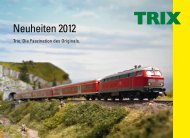Brawa - Micro Macro Mundo
Brawa - Micro Macro Mundo
Brawa - Micro Macro Mundo
You also want an ePaper? Increase the reach of your titles
YUMPU automatically turns print PDFs into web optimized ePapers that Google loves.
Covered Freight Car IE DSB<br />
Road no. 18 800<br />
Tank Car DRG<br />
Road no. 501 132 P<br />
Larger tank car models were to be used after<br />
the First World War in order to reduce unladen<br />
weight and train lenghts. Krupp commenced<br />
production of larger tank cars in<br />
1922. The first models were used for the<br />
transportation of tar. They weretwo-axle cars<br />
with four wheelbases - a model between the<br />
two-axle cars and the present-day four-axle<br />
cars with bogies.<br />
DELIVERY DATE: 2ND QUARTER 2012<br />
LAYOUT VERSION<br />
Order no. 48261 Order no. 47061<br />
In 1919, Danish privately-owned railways<br />
ordered 50 closed goods waggons (boxcars)<br />
from Christoph & Unmack in Niesky, which<br />
corresponded to the Prussian A2 master drawing<br />
to the greatest extent possible. The<br />
Danish State Railway (DSB) took over 14 of<br />
these waggons in 1939/40 and classified them<br />
as IE 18787–18800. In Denmark, the „I“<br />
represents closed waggons for non-contaminating<br />
goods such as meat, butter, eggs, and<br />
milk – nevertheless they are not refrigerator<br />
vans. The last of these waggons were taken<br />
out of service in 1966, but still served as station<br />
waggons at various stations. One was restored<br />
to its original condition in Niesky in<br />
2009, commemorating the 175th anniversary<br />
of the local railway carriage construction.<br />
DELIVERY DATE: 2ND QUARTER 2012<br />
Model: Extra mounted steps and handrails in low-material thickness; authentically reproduced chassis; metal wheels<br />
Model: Wheelsets in toe bearing; applied grab rails and steps in low material thickness; close coupling; extra steps; undercarriage<br />
with extra brake system; extra signal holder; many extra parts such as door latches<br />
Covered Freight Car CHDG NS<br />
Road no. 10 139<br />
Tank Car “DEROP“ DRG<br />
Road no. 565 275 P<br />
LAYOUT VERSION<br />
Order no. 48262 Order no. 47065<br />
LIEFERTERMIN: 2. QUARTAL 2012<br />
The Dutch state Railways (Nederlandse Spoorwegen<br />
- NS) also had closed waggons already<br />
before the war that were reminiscent of the<br />
Prussian A2 master drawing. More waggons<br />
were added as a result of the war. The NS<br />
attached special retention walls to the waggons<br />
in order to be able to transport grain in<br />
bulk. That was the preferred storage type for<br />
this good all throughout Europe. Special container<br />
waggons weren‘t built for this purpose<br />
in large numbers until the late 50s.<br />
DELIVERY DATE: 2ND QUARTER 2012<br />
Tank Car “ESSO“ DB<br />
Road no. 585 689 P<br />
Covered Freight Car Lw SNCF-<br />
EUROP<br />
Road no. 7 492 478<br />
The „Standard Oil Company of New Jersey“,<br />
formed as part of the break-up of the Standard<br />
Oil Trust, was abbreviated to SO, reflected<br />
in the name „Esso“, which was later<br />
renamed Exxon. The German subsidiary operated<br />
as D.A.P.G. (Deutsch-Amerikanische<br />
Petroleum Gesellschaft) until the start of the<br />
war. Together with IG Farben, they held a stake<br />
in Deutsche Gasolin, and cooperated in<br />
the production of synthetic oil. After the war,<br />
Esso became a brand name in Europe as well.<br />
ExxonMobil currently operates gas stations in<br />
Europe under that name. In order to increase<br />
brand awareness, Esso placed advertisements<br />
on the tank waggon of several European railway<br />
administrations.<br />
DELIVERY DATE: 2ND QUARTER 2012<br />
Order no. 48263 Order no. 47062<br />
The Alsace-Lorraine Imperial Railways procured<br />
a large amount of operating equipment<br />
according to Prussian standards for uniform<br />
design and construction („Normalien“).<br />
Many of these waggons were transferred to<br />
the newly established French state railway<br />
SNCF in 1938. Many other freight waggons<br />
of German design were transferred to the<br />
SNCF after 1945. In 1951, the Deutsche Bundesbahn<br />
(DB) and the SNCF founded the<br />
EUROP wagon pool, in which open and<br />
closed goods waggons were placed together<br />
for common use. In addition to waggons in<br />
accordance with OCEM design principles, the<br />
SNCF also placed numerous waggons of German<br />
origin or in accordance with German<br />
pattern drawings in the EUROP wagon pool.<br />
Among them were also numerous G waggons<br />
following the Prussian A2 master drawing.<br />
DELIVERY DATE: 2ND QUARTER 2012<br />
68 FREIGHT CARS<br />
69



